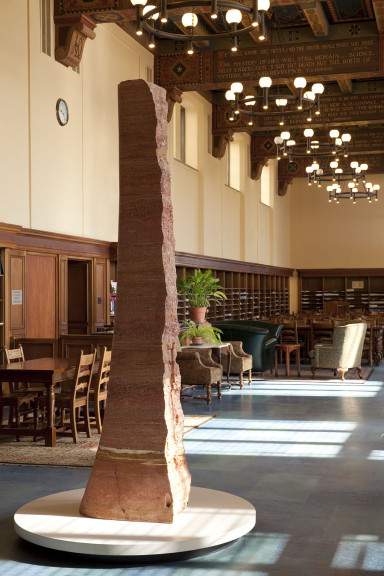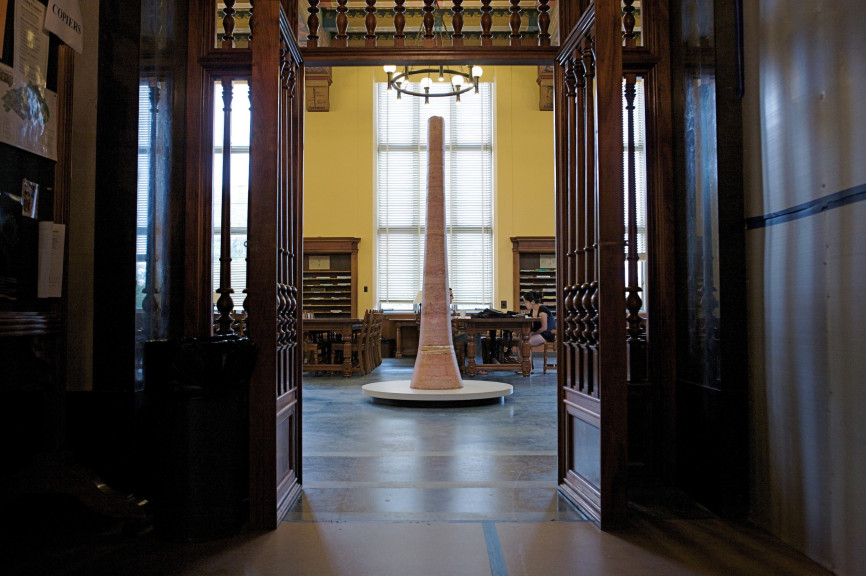Pedogna
Walter Dusenbery
102 1/2 × 25 1/2 × 21 1/2 inches
Photography not permitted
Lent by The Metropolitan Museum of Art
Gift of Doris and Jack Weintraub, 1979
1979.300a-h
GPS: 30.286167,-97.739029
Born in Alameda, California, Walter Dusenbery has an artistic lineage that follows an impressive line of masters. After studying at San Francisco Art Institute and the California College of Arts and Crafts, Dusenbery assisted Japanese–American sculptor Isamu Noguchi (1904–1988)—a student of modernist master Constantin Brancusi (1876–1957), who, in turn, had worked in the Parisian workshop of Auguste Rodin (1840–1917).
As a young artist, Dusenbery preferred the tradition of direct carving over the popular method of welding metal sculpture that was prevalent during the 1950s and ‘60s. Many direct-carve sculptors feel a strong physical and psychic connection to the natural materials they use, a sensitivity that Dusenbery shared with Noguchi. While Noguchi worked in fine marbles and rough basalt, Dusenbery favored travertine, a porous carbonate stone that is easily cut. In its pure state, travertine is white, but mineral or biologic impurities can infuse the stone with color, such as the reddish hue of Pedogna.
A large form like Pedogna requires considerable geometric calculation and planning. The artist first created a smaller-scale preparatory version of the sculpture from a single piece of red Verona marble. With a footprint shaped like a horseshoe, the sculpture features two contrasting silhouettes—a smoothly rounded edge that arcs upward from the base, and a coarsely chiseled surface that emphasizes the intrinsic qualities of the finely grained stone. The juxtaposition between these two textures reflects Dusenbery’s evolution as an artist; though trained in direct carving, he has since become a pioneer in three-dimensional scanning and computer controlled fabrication.
The title of the sculpture refers to the secluded Pedogna Valley in the Tuscan region of Northern Italy, located about an hour west of Dusenbery’s studio in Pietrasanta. Pedogna conveys a geological history much older than that of ancient Rome. With striations formed over hundreds of millions of years, the sculpture evokes an ancient aura, referencing sources like the mysterious dolmens of Stonehenge and the lingams of Shiva in India.
ACTIVITY GUIDES
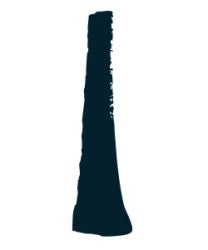
Pedogna
Walter Dusenbery
Subject: Contrasting textures
Activity: Create assembled pieces from found texture samples
Materials: Different texture samples; for example, sandpaper, soda cans, leaves, cotton balls, stones, clay, etc., and adhesive
Vocabulary: contrast, interstice, texture, travertine
Walter Dusenbery was born in Alameda, California, in 1939. He studied at the San Francisco Art Institute and then the California College of Arts and Crafts, where he received a Master’s of Fine Arts (MFA) degree. Dusenbery’s favorite material was travertine, a kind of stone that is easily cut. In its pure state, travertine is white, but impurities can make it look yellow, red, brown, gray, and green. Some travertine deposits have solid impurities, including tiny fossils.
The title of this sculpture refers to the quarry in Tuscany, Italy, from which the stone came. The term “travertine” derives from the Latin name of the place in Italy that provided the ancient Romans with the stone used to build the Coliseum. Pedogna has two kinds of surfaces: a smooth, round, and bell-shaped base with rough interstices. The contrast between roughness and smoothness lends visual interest.
Why do you think Dusenbery named his sculpture after a quarry in Italy?
Why would it be important where the stone was from?
How would you describe the different textures you see?
How would the textures be different if this sculpture were made of wood or metal?
Collect different texture samples, for example, clay, cotton balls, leaves, sandpaper, soda cans, and stones.. Choose a way to assemble your objects. You might choose to use glue, wire, or string. Think about how the different textures create contrast. What else besides texture can create contrast? Color? Weight? The object’s purpose?
Dusenbery worked for a time as a studio assistant to the very famous Japanese American sculptor Isamu Noguchi.
Pedogna by Walter Dusenbery and Untitled (Seven Mountains) by Ursula von Rydingsvard were both made by stacking.
Compare the two sculptures. Why do you think the artists chose this method to make their sculptures?
Contrast -two or more unlike elements (as color, tone, or emotion) in the same work of art
Interstice - a space between things, especially one between closely spaced things
Texture - the visual or tactile surface of something
Travertine - a mineral consisting of layered calcium carbonate formed by deposits from spring waters, especially hot springs
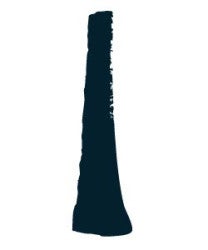
Pedogna
Walter Dusenbery
Subject: Texture
Activity: Create a rainbow of different textures
Materials: Texture samples (cotton ball, fabric, sand paper, stone, etc.)
Vocabulary: artist, carve, marble, sculpture, texture
Explain to your child that texture is the way something feels. Things can have many different textures, including rough, scratchy, smooth, or soft.
Sometimes we can look at things and imagine how they would feel if we touched them. Artists create textures in their sculptures, knowing that we will see them. This artist carved the marble in his sculpture so it would have many different textures.
What material did the artist use to create this sculpture?
Can you see rough parts? Smooth parts?
How would you describe the textures?
What do the textures remind you of?
How would the textures be different if this sculpture were made of wood or metal?
Note that different textures both come from materials and from techniques. This sculpture is rough and smooth because of the carving, while the marble material remains porous. Ask your child to think about the textures that different materials have (concrete, metal, stone, wood) as well as how different techniques (sanding, scratching, polishing) may make them feel different.
Collect a variety of samples that have different textures. Encourage the child to touch the samples and arrange them in order, like a rainbow, from smooth to rough.
Artist - someone who makes things, such as paintings and sculptures
Carve - to cut away from a surface
Marble - a rock often used in making sculptures
Sculpture - a work of art that has height, width, and depth
Texture - how something looks or feels, rough or smooth for example
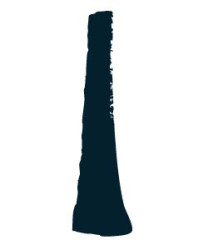
Pedogna
Walter Dusenbery
Subject: Texture
Activity: Make a collage from textured rubbings
Materials: Paper, crayons or pencils, scissors, and glue or tape
Vocabulary: Sculpture, texture, carve, quarry, travertine
Walter Dusenbery lives and works in Italy. This sculpture is named for the town in which he lives. It is also the name of the quarry from which the stone was mined. The stone is called travertine and it is very soft and easy to carve. With this sculpture, the artist used both smooth and rough pieces of stone. Dusenbery believes that by sculpting with natural materials (such as wood, clay, or in this case, stone) you can be closer to the natural environment.
The stone used to make this sculpture is very soft. How might the sculpture and its texture be different if it was made with very hard stone?
How do the rough pieces look compared to the smooth ones beside them? How would the sculpture be different if it had one uniform texture?
Why do you think the artist named this sculpture after the place from which the stone was mined? Why would this information be important to him?
In your house and yard find objects that have texture, such as the bark of a tree, concrete, or the tiles in your kitchen. Lay a piece of paper over them and rub the paper with a crayon or pencil. Notice the pattern or texture that is now on the paper. Once you have collected several textures on paper, use scissors to cut them into different shapes. Now glue them onto another sheet, making a scene or picture.
Sculpture —A work of art that has height, width, and depth
Texture —How the surface of something looks or feels (for example, rough or smooth)
Carve —To cut away from a surface
Quarry —A hole or pit from which stone is excavated
Travertine —White or light-colored calcareous rock deposited from mineral springs
MORE INFORMATION
Born in Alameda, California, Walter Dusenbery studied at the San Francisco Art Institute, and then received an MFA from the California College of Arts and Crafts. Contrary to the importance of welded metal sculpture in America at that time (see entries on Anthony Caro and Seymour Lipton), Dusenbery preferred the older tradition of direct carving.
Dusenbery worked for a time as studio assistant to the Japanese American sculptor Isamu Noguchi (1904–88), who was one of the most innovative carvers in the world, working in fine marbles, variegated granites, and rough basalt. Noguchi was a passionate believer in the “direct-carve” practice advocated by Constantin Brancusi (1876–1957) in the early twentieth century (Noguchi had worked as Brancusi’s assistant in Paris in the late 1920s).
Many direct-carve sculptors feel a strong physical and psychic link with the natural materials they use, as Noguchi once noted: “I love the use of stone, because it is the most…meaning-impregnated material. The whole world is made of stone.…Stone is the direct link to the heart of matter—a molecular link. When I tap it, I get an echo of that which we are. Then, the whole universe has resonance.”
Like Noguchi, Dusenbery often carved vertical, totemic abstract sculptures from a single massive stone. These monoliths intentionally convey an ancient aura, evoking sources like the mysterious dolmens of Stonehenge and the lingams of Shiva in India.
Pedogna, 1977
Dusenbery’s favorite material was travertine, a porous carbonate stone that is easily cut. In its pure state, travertine is white, but mineral or biologic impurities can infuse the stone with yellow, red, brown, gray, and green hues. Some travertine deposits are characterized by solid impurities, including tiny fossils.
The title of this sculpture refers to the secluded Pedogna Valley in Northern Italy that can only be reached by foot. The term “travertine” derives from the Latin name of the place in Italy where the ancient Romans quarried the stone used to build the Coliseum. Dusenbery was initially introduced to this material while working with Noguchi in the stone-working areas of Italy. Although Pedogna is travertine, it is made of a Persian variety that the artist often uses.
Geologically, Pedogna conveys a history much older than that of ancient Rome. The sculpture celebrates the wonders of the natural environment with striations formed over hundreds of millions of years. Interestingly, the artist chose not to arrange Pedogna’s segments in geological order. Like in many of Dusenbery’s sculptures, he enjoys playing with questions of time.
Although known for his direct-carve sculptures, Dusenbery did not make Pedogna in the direct-carve method. He explained that sculptures of this scale are too large to carve directly; they require considerable geometric calculation and planning.
Pedogna manifests two kinds of articulated surface: a smooth, round, and bell-shaped base with a rusticated side. The contrast between rough chiseling and a sensuous smoothness provides visual interest and emphasizes the intrinsic qualities of the hard, finely grained stone.
Valerie Fletcher is Senior Curator at the Hirshhorn Museum in Washington, DC. Her research on groundbreaking aspects of international, globalized, and transnational art have resulted in numerous exhibitions and publications.
French-frazier, Nina. “Walter Dusenbery.” Arts Magazine 52 (June 1978): 10.
Gruber, Terry deRoy. “Walter Dusenbery.” Arts Magazine 50 (February 1976): 6.
Nassau County Museum of Fine Art. Walter Dusenbery. Roslyn, NY, 1981. Text by Peter Walker.
Phillips, Deborah C. “Walter Dusenbery.” Arts Magazine 55 (January 1981): 4.
University of Northern Iowa Art Department. Walter Dusenbery: Classical Echoes. Cedar Falls, IA, 1985. Texts by Daniel E. Stetson and Tim Threlfall.
The Metropolitan Museum of Art in New York generously loaned twenty-eight modern and contemporary sculptures to Landmarks for display throughout the Austin campus. The collection represents a broad array of artists working in the second half of the twentieth century. The initial sculptures were installed throughout the main campus in September 2008, and a second, smaller group were unveiled at the renovated Bass Concert Hall in January 2009.
Funding for the loan was provided by the Office of the President. This project was the result of a collaborative effort among many, including:
Leadership
Andrée Bober and Landmarks
Pat Clubb and University Operations
Douglas Dempster and the College of Fine Arts
Landmarks Advisory Committee
William Powers and the Office of the President
David Rea and the Office of Campus Planning
Bill Throop and Project Management and Construction Services
Gary Tinterow and the Metropolitan Museum of Art
Samuel Wilson and the Faculty Building Advisory Committee
Project Team
Chuck Agro, transportation, Metropolitan Museum of Art
Andrée Bober, curator and director, Landmarks
Caitlin Corrigan, registrar, Metropolitan Museum of Art
Cynthia Iavarone, collections manager, Metropolitan Museum of Art
Cliff Koeninger, architect
Ricardo Puemape, Project Management and Construction Services
Kendra Roth, conservator, Metropolitan Museum of Art
Patrick Sheehy, installation services
Nicole Vlado, project manager, Landmarks
Special Thanks
Valerie Fletcher, curatorial contributor
Beth Palazzolo, administrative coordination, University Operations
Russell Pinkston, composer
What’s Past Is Prologue: Inaugurating Landmarks with the Metropolitan Sculptures
With the arrival of twenty-eight modern sculptures on long-term loan from New York’s Metropolitan Museum of Art, the Landmarks program has begun. Their installation throughout the Austin campus offers a remarkable opportunity to survey some of the major trends in art during the second half of the twentieth century. These sculptures allow us to witness the distinctly modern dialogue between representation and abstraction, as well as the contest between natural and industrial materials. Most of all, we can celebrate their presence as an unprecedented chance to experience works of art first-hand––to appreciate their forms and to understand the underlying ideas.
The Landmarks program perpetuates in Austin one of civilization’s oldest and most enduring traditions: the placing of art in public areas, accessible to nearly everyone and expressive of collectively held ideas. More than five thousand years ago, the cultures of Egypt and Mesopotamia produced sculptures for urban plazas, government buildings, and places of worship to express political, secular, and religious values. Grand monuments endorsed the ruling elite and commemorated military victories, while images of deities symbolized spiritual beliefs. The original purposes of public art were primarily ideological and didactic, but what has endured through the ages is the physical beauty of the art. In modern times the contexts and goals for public art have changed considerably. In many parts of the world democracy and egalitarianism have supplanted absolute rulers, and explicit religious power has yielded to secular humanism. During the mid-to-late twentieth century (the era when the Metropolitan’s sculptures were created), globalization has redefined the entire world. Societies in Europe and the Americas have became so diverse that cultural authorities can no longer be sure of which systems of meaning and which values, let alone which individuals, should be honored in the traditional ways of public art.
A schism has developed between traditionalists and modernists. In a rapidly changing world those who wanted to preserve the familiar in art have continued to commission representational statues. Modernists, on the other hand, have embraced change and gladly jettisoned the old ways in favor of abstraction. The schism is exemplified by two famous memorials in Washington, D.C., both intended to commemorate the heroic sacrifices of American armed forces. The Marine Corps Memorial (1954) consists of a superbly realistic representation of soldiers struggling to raise the American flag on Iwo Jima in 1945. In contrast, the Vietnam Memorial (1982) consists of a massive V-shaped wedge of polished black stone inscribed with What’s Past Is Prologue: Inaugurating Landmarks with the Metropolitan Sculptures July 2008 the names of the dead. At the time it was inaugurated, this monument shocked nearly everyone outside the art world and outraged many of those it intended to commemorate. In response, a group of bronze figures of soldiers was added. But soon, precisely because of its universal form and absence of imagery, the original memorial became a powerful place where all Americans could go to grieve, remember, and pay homage. To most of the art world, this demonstrated beyond a doubt the viability of abstract sculpture for public places.
With America’s increasing wealth and social consciousness in the 1960s many towns began to institute programs of commissioning sculptures for public places. By requiring that 1 or 2 percent of each building’s construction budget be used for art, urban planners sought to improve the living and working environment for millions of people. The main difficulty was agreeing on what kind of art was visually pleasing and, just as important, potentially meaningful to the general public. Two highly publicized examples were the huge, abstract, metal sculptures by Pablo Picasso and Alexander Calder, in Chicago and Grand Rapids respectively, which at first provoked derision but gradually became a source of community identity and pride.
One way to approach works of art is to consider the historical context in which they were created. During the first half of the twentieth century, life and art underwent radical transformations. Industrial manufacturing supplanted agriculture as the dominant mode of production, people migrated from rural areas to urban centers, women and minorities gained equal rights, warfare expanded to an unprecedented global scale, and technology accelerated the pace of life—and art changed in tandem.
Abstraction
Early in the modern era, many artists believed that a new visual language was needed to replace the Greco-Roman classical figurative traditions that had persisted through two millennia. Photography had made mimesis (accurate depiction of reality) unnecessary in painting and sculpture for the first time in history. Artists were free to conceive radically new approaches, and so abstraction was born, emerging from 1910 to 1920 in Europe. Initially artists simplified and stylized observed reality into organic and angular forms. That first phase soon evolved into making “pure” abstractions with no recognizable sources. From the outset, abstract art carried implicit meanings recognized by artists and informed viewers but largely lost on the general public.
Early abstractionists intended their art to convey their commitment to an ongoing transformation of society. Like Morse code in telegraphy and other new modes of communication fundamentally different from the traditional written word, abstract forms in art could convey meanings—not narrative or literal ones but broad ideas that could speak to an international audience and help advance human consciousness.
During the 1920s and 1930s, artists developed two broad types of abstraction: geometric and biomorphic. Geometry denotes mathematics and suggests such related disciplines as architecture, design, engineering, and logic as well as intangible qualities like analytical thinking and precision—desirable attributes for a rational, communal society. Artists devised a new language of geometry in art: horizontal and vertical elements can convey calm, harmony, and stability (see Harmonious Triad by Beverly Pepper), while rising diagonals can suggest energy and optimism (see Column of Peace by Antoine Pevsner and Square Tilt by Joel Perlman).
In contrast to geometric abstraction, a number of artists favored softer forms and curving contours. Inspired by sources in nature, biomorphic abstractions evoke natural phenomena, biological processes, growth, and ambiguity (see Big Indian Mountain by Raoul Hague, Source by Hans Hokanson, and Untitled [Seven Mountains] by Ursula von Rydingsvard). Such works stand in general opposition to the industrial and technological aspects of modern life; they remind us of the fundamental importance of the natural world. Biomorphism was invented and advocated by the surrealists, who believed in the importance of the unconscious mind in creating and understanding modern art. Relying on the Freudian concept of free association, such artists expect viewers to generate their own unique responses to abstract art.
The two types of abstraction began as competing and opposing philosophies, but by the 1950s many artists expertly combined them to suit their expressive needs (see the rhythmic contours of Veduggio Glimpse by Anthony Caro and the disconcerting, hulking forms of Catacombs and Guardian by Seymour Lipton).
By the 1960s, the original philosophical meanings underlying abstraction had mostly faded away, leaving “formalist” aesthetics: the creation and appreciation of pure nonreferential beauty. Formalism dominated much artistic practice from the 1950s through the 1970s, particularly in the United States in the circle around the critic Clement Greenberg. Geometric sculptures became ubiquitous in public places—some complex and sophisticated and some merely competent. A group known as the minimalists advocated an intellectually rigorous, austerely reductivist approach (see Amaryllis by Tony Smith). Other artists went in the opposite direction, toward complexity and a decorative verve (see Kingfish by Peter Reginato). From those extremes emerged the postminimalists, who infused organic vitality into simple, singular forms (see Curve and Shadow No. 2 by Juan Hamilton).
Figuration
Despite the enthusiasm for abstraction in midcentury, a number of artists insisted on maintaining recognizable human content in their works. Abstraction had alienated many viewers who found it remote or incomprehensible. Yet few artists returned to traditional realism, preferring instead to explore new and evocative modes of representation.
The strongest resurgence occurred in the aftermath of World War II. Many artists, especially in Europe, wanted to pay homage to the sufferings experienced by so many people during the war and to their struggles to rebuild their lives and societies amidst the new fears engendered by the nuclear age and the Cold War. This atmosphere of postwar existential anxiety was poignantly expressed in two museum exhibitions in the 1950s: models for a never-realized Monument to the Unknown Political Prisoner at London’s Tate Gallery in 1953 and the avowedly humanist theme of the New Images of Man installation at New York’s Museum of Modern Art in 1959.
Many postwar sculptors expressed their angst by portraying figures or fragments of bodies as falling, broken, injured, or partially robotic (see Augustus by Bernard Meadows and Figure by Eduardo Paolozzi). Some erudite artists reinterpreted classical myths, particularly those in which a hero challenged the gods and were punished: Icarus, Hephaestus, Prometheus, Sisyphus (see works by Koren der Harootian and Frederick Kiesler). Seymour Lipton created a particularly effective amalgam of figure references within abstract forms that harbor dark inner spaces (see Pioneer, Catacombs, and Guardian).
Representational sculpture was submerged by the tidal wave of abstraction in the 1960s and 1970s, but a new generation insisted on a legible humanist content in art, addressing issues of personal identity and isolation in an impersonal world (see Eyes by Louise Bourgeois and Figure on a Trunk by Magdalena Abakanowicz).
Materials and Methods
Modern sculptors also introduced a new language of materials and methods. In the late nineteenth century, sculpture making had entered a new phase of mass production made possible through technology: bronzes could be produced in large editions by skilled technicians from an artist’s original. The Thinker by Auguste Rodin, for example, was made in several editions, ranging from a dozen life-size bronzes to hundreds of smaller casts. This mechanization and concomitant commodification of art prompted a reaction. Appearing simultaneously in several countries, the “direct carve” movement advocated older craft-based methods and sought to enhance the intrinsic characteristics of natural materials: the color and grain of exotic woods or the veining and crystalline structure of unusual stones. By the 1920s, this aesthetic had gained international prominence, and it persists to this day.
The first generation of direct carvers admired prehistoric, African, Oceanic, and indigenous American artifacts. By adapting the hieratic frontality and stylized forms of those sources to the sleekly refined forms of abstraction, modern sculptors could represent simplified figures linked in sophisticated linear rhythms (see works by Koren der Harootian and Anita Weschler). Recent artists of this orientation tend to work on a larger scale and may roughly cut and hew wood to achieve expressionistic textures (see works by Hans Hokanson and Ursula von Rydingsvard).
Carvers remained a relatively small minority in modern sculpture, far outnumbered by “direct metal” sculptors. Their approach emerged in prewar Europe and burgeoned into an international movement in the 1950s and 1960s. Seeking materials and methods appropriate to the modern Machine Age, artists looked to engineering and construction for inspiration. Instead of using chisels to carve wood and stone, constructivists preferred welding torches to cut and join pieces of metal. Their structures ranged from elegant abstractions to assemblages of cast-off objects.
The industrial analogy and model extended to the sculptors’ own studios, which resembled factory spaces with heavy-duty equipment. Some—like Anthony Caro, Willard Boepple, and Robert Murray—found inspiration in working spontaneously and experimentally with sheet metal: cutting, folding, rolling, welding, soldering, and sometimes painting or burnishing it. Other sculptors, notably Tony Smith, were comfortable with sending models to factories for professional fabrication. Both methods were considered appropriate for a modern world that had been so fundamentally reshaped by industrial manufacture.
In contrast, many sculptors preferred to make assemblages from miscellaneous bits and pieces of scrap, sometimes irreverently called “junk sculpture.” Although artists had experimented with this approach as early as the 1910s, it became a widespread tendency only decades later in the 1950s and 1960s, when sculptors made three-dimensional collages from the detritus of industrial manufacture and mass consumption: rusty machinery, old car parts, squished used paint tubes, broken musical instruments, virtually anything. The motivations for using trash range from simple necessity (when an artist has no money to buy new materials) to antimaterialistic social criticism and environmentalism (sculptors started recycling long before the idea occurred to others).
Regardless of the motivations, a found-object sculpture possesses an inherent dual identity: its former reality as a useful thing and its new reality as art. That dualism inevitably poses an intellectual and visual conundrum for us. Do we see Deborah Butterfield’s Vermillion primarily as a lifelike depiction of a horse or as a composition of rusty, crumpled bits of metal thrown out by a wasteful consumerist society? And what are we to understand from Donald Lipski’s seemingly abstract The West, which consists of decontextualized harbor buoys and lots of corroded pennies? The artists offer clues and hope that we will use our own eyes, intellect, intuition, and imagination to make connections and create meanings.
Landmarks: Sculptures for Inquiring Minds
Unlike works in private collections or even museums, public sculptures exist in our daily environment, interact with our activities, and enter our awareness repeatedly and variously. Beyond the pleasure they bring to viewers already acquainted with art, they can stimulate curiosity and spark new perceptions in the minds of passersby who might otherwise not have much aesthetic experience. As the university’s population seeks knowledge in classes, libraries, and laboratories, the Landmark sculptures can offer other kinds of discoveries. Visitors to the Perry Castañeda-Library, the Nano Science Technology Building, the School of Law, and elsewhere on the campus can now see immediately that the visual arts have a prominent place and come away enriched. Very few campuses or cities can boast so many sculptures of such quality that are free and accessible to all. The twenty-eight sculptures from the Metropolitan Museum of Art proclaim the broad purpose of the Landmarks program: to bring an important new dimension to the life of the university, to the everyday experience of its students, faculty and staff, the citizens of Austin and beyond, and to any person who just crosses the campus.
Valerie Fletcher is Senior Curator at the Hirshhorn Museum in Washington, D.C. Her research on groundbreaking aspects of international, globalized, and transnational art have resulted in numerous exhibitions and publications.

